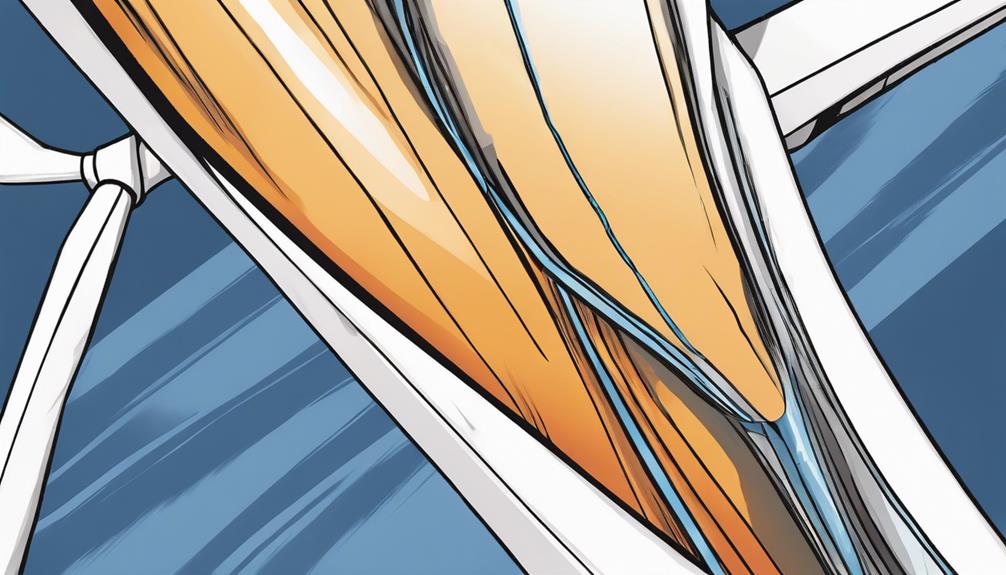Wind turbines in Australia cause many bird and bat deaths each year. Over 10,000 birds and tens of thousands of bats die from hitting them. In North America, the count reaches close to a million bats annually. Yet, we can reduce these sad events with some simple changes. This allows wind energy to work well with nature.
Key Takeaways:
- Wind turbines in Australia cause the death of over 10,000 birds and tens of thousands of bats annually1.
- In North America, wind turbines are responsible for close to a million bat fatalities each year1.
- Implementing measures such as raising wind speed thresholds and using ultrasonic deterrents can significantly reduce wildlife collisions1.
- Wind energy projects contribute to greenhouse gas reduction, job creation, and a diverse power grid2.
- Wind turbines have a low impact on birds and bats compared to fossil fuel generation3.
- Job Creation: Communities see more jobs from wind energy projects. This helps the community grow4.
- Revenue Generation: Wind farms bring in money through taxes and renting land. This money supports community services and infrastructure.
- Clean and Affordable Energy: Being near wind farms means access to renewable energy. This cuts down on fossil fuel use and is better for the planet5.
Benefits of Living Near Wind Farms
Living close to wind farms offers several advantages to local areas. These include:
Wind energy projects often propose community benefit agreements. These agreements provide extra benefits to local people. They are especially talked about for wind power in the ocean.
Studies show home prices may drop near wind farms at first. But within 3 to 5 years, they bounce back to normal levels. So, the drop in property values is only short-term5.
Overall, wind farms can lead to more economic growth. They offer clean energy and help local areas develop sustainably.
Concerns of Living or Working Near Wind Farms
People who live or work close to wind farms often have worries. These include noise, shadow flashes from the blades, radar issues, and effects on nearby industries. It’s key to pick the right sites and take steps to lessen these concerns. This will help wind projects and local areas get along better. Wind energy companies talk a lot with communities to find and reduce any issues.
One big worry is the noise wind turbines make. Not everyone hears this noise the same way. According to6[1], about 39% of people said they could hear the turbines from their homes. The louder the noise, the more people noticed it. For example, at a sound level of 29 dB(A), between 5-15% noticed the noise. At 41 dB(A), that number soared to 45-90%.
Noise can also disrupt sleep. The mentioned study found more sleep problems at 40 dBA and 45 dBA. The number of annoyed individuals also rose with the noise level. Up to 30% felt very annoyed at levels over 37 dB(A). Plus, 23% had their sleep disturbed by wind turbine noise. This suggests turbine noise might be more bothersome than other noises at similar levels.
Shadow flicker is when turbines cast moving shadows. It happens under certain conditions, like when the sun is low. Developers assess and reduce its impact in the early planning stages.
Radar interference comes up with farms near radar sites, such as airports or military bases. Thanks to studies and new technology, developers have found ways to lessen radar issues. They work with authorities to keep radar systems clear while using wind power.
Wind farms might also affect other industries or land uses. It’s critical to find a good balance between renewable energy and preserving other activities. Wind farm planning includes talks with locals to find spots that reduce negative effects on farms or wildlife areas.
Statistical Data Summary
| Data | Source |
|---|---|
| 39% of respondents noticed sound from wind turbines outside their dwellings | 6[1] |
| Increase in sound pressure level led to a linear increase in the proportion of respondents noticing sound | 6[1] |
| Sleep disturbance spiked at 40 dBA and 45 dBA | 6[1] |
| A significant proportion of participants (up to 30%) reported being very annoyed at sound levels above 37 dB(A) | 6[1] |
| 23% of respondents reported being disturbed in their sleep by noise from wind turbines | 6[1] |
In the end, although concerns are there, right site choosing and good talk with the community can help. By tackling issues like noise, shadow flicker, radar problems, and impacts on other areas, wind energy aims for a sustainable future. This keeps communities happy and supports wind power growth.
Wind Farms and Human Health
Wind energy is clean and green, making it a popular choice in recent years. But, as wind farms grow, so do concerns about their effect on human health. Some people feel annoyed by wind turbines, but no proof exists that wind farms harm health.
The rise in wind power has been impressive, with a nearly 100-fold increase in 20 years7. Ten countries lead in wind energy, making up over 80% of global wind electricity7. For instance, Iowa generates ten times more wind energy than Wisconsin7. Wind energy meets 37% of Iowa’s needs opposed to 2.3% in Wisconsin7. This shows how effective wind farms can be in replacing fossil fuels.
When looking at wind turbines and health, studies find little proof of harm7. Research doesn’t support the idea that wind turbine noise causes sleep or stress problems7. Also, there’s no link between this noise and hearing loss7. In Alberta, Canada, wind turbines cause fewer noise complaints than other energy sources do7.
Annoyance from turbine noise is the main complaint, says the Council of Canadian Academies7. This annoyance varies by person and is more likely at noise levels above 40 dB(A)8. People who profit from wind farms on their land report less annoyance, despite similar or louder noises8.
As for electromagnetic fields (EMF), studies say there’s little worry. Near turbines, EMF levels are much lower than what people face daily9. In Bulgaria, EMF levels near turbines were significantly lower than harmful levels9. The Ohio Department of Health also found no health issues from wind turbine EMFs9.
Though it’s key to listen to community worries, research shows wind farms are safe for our health. Wind energy plays a big role in moving to cleaner power. It’s crucial to use solid evidence for decisions to ensure wind farms and people can get along well.

| Data | Reference |
|---|---|
| Global wind electricity generating capacity increased almost 100-fold in just over 20 years | 7 |
| Ten countries are responsible for over 80% of all wind-produced electricity worldwide | 7 |
| Iowa has ten times the wind energy capacity compared to neighboring Wisconsin | 7 |
| Wind energy in Iowa contributes to 37% of the state’s electricity | 7 |
| Wind turbines have been linked to feelings of annoyance, but limited evidence exists for a causal relationship with sleep disturbance or stress | 7 |
| No evidence found linking hearing loss to wind turbine noise at associated sound pressure levels | 7 |
| Noise complaints in Alberta related to wind turbines were fewer compared to complaints about other energy activities | 7 |
| Review by Council of Canadian Academies found annoyance as a common health effect attributed to turbine noise | 7 |
| Magnetic field levels near wind turbines were found to be lower than those encountered in daily environments | 9 |
| Researchers in Bulgaria found that EMF levels near wind turbines were four orders of magnitude lower than levels known to cause harm to human health | 9 |
| The Ohio Department of Health concluded that there is no public health burden from electromagnetic fields generated by wind turbines | 9 |
Safety Measures at Wind Farms
Safety is always first in creating and managing wind farms. Wind energy’s rise means we must focus on keeping everyone safe. Various steps and rules help lessen dangers and keep turbine operations safe.
Icy turbine blades are a problem at wind farms. Yet, modern turbines handle extreme cold, down to -40°C. They have special gear to stop ice build-up and keep things safe even in icy weather10.
The risk of a turbine blade coming off during use is low. Thanks to new tech and sensors, modern turbines almost never have this issue. This means they are safer to use10.
High wind turbines can get struck by lightning. They have special systems to deal with lightning and keep the turbine safe. This helps keep both the turbine and nearby areas safe10.
New turbine designs are tested for safety in tough weather, like strong winds. These tests find any weak spots. This lets makers improve them for better safety10.
Small wind turbines, less than 100 kilowatts, get checked for safety. They are certified by groups like the Small Wind Certification Council and UL. This means they meet important safety standards10.
Building and looking after wind farms follows strict safety rules. Workers learn about safety and wear gear to keep them safe from dangers like falls and harmful dust11.
Only skilled workers should handle cranes at wind farms. This makes sure heavy parts are moved safely and well11.
Workers sometimes go into tight spaces in turbines. They need clear ways out to avoid feeling trapped. They also learn first aid in case getting to a hospital takes too long11.
Offshore wind farms have their own risks, like noise and slippery decks. Workers need good training and clear communication to stay safe on the sea11.
Crosby Airpes makes lifting gear just for wind energy’s needs. The right lifting tools are key for safely putting up and fixing wind turbines12.
Good training, strict safety steps, and the right equipment are crucial for wind farms. These efforts show the wind industry’s focus on keeping workers safe and turbines running smoothly12.Safety Measures at Wind Farms: Summary
| Safety Measures | Wind Farms |
|---|---|
| Ice accumulation on turbine blades | Anti-icing and de-icing technologies |
| Blade throw | Improved engineering, hazard sensors |
| Lightning strikes | Lightning protection systems |
| Turbine design | Rigorous testing for resilience |
| Small wind turbines | Certified to safety standards |
| Construction and maintenance | Adherence to safety protocols, PPE, fall protection systems |
| Confined spaces | Clear exit routes |
| First aid training | Remote location challenges |
| Offshore wind farms | Noise exposure, slippery conditions, vessel risks |
| Lifting equipment | Crosby Airpes specialized solutions |
| Comprehensive training | Stringent safety measures |
| Safety commitment | Worker well-being, optimal functioning |

Wind farms are committed to safety, with measures and checks that keep workers and communities safe. By improving safety and using trusted equipment, the wind energy field works to be safe and green for all.
Shadow Flicker and Wind Farms
Shadow flicker happens when wind turbines cast moving shadows. This can concern people who are sensitive to flickering lights.
Modern turbines have reduced shadow flicker’s impact. The blades spin no faster than 20 revolutions per minute. This creates shadow flicker at a rate below 60 rpm13. It’s under the 120 flashes per minute that might cause epilepsy13. So, the risk of seizures from shadow flicker is very low.
Developers use computer models to study and lessen shadow flicker13. They can figure out when, where, and how much shadow flicker will happen. This helps in choosing where to put turbines13. With these models, they can reduce potential problems.
There are rules about how far wind turbines must be from buildings13. Smaller turbines cause less shadow flicker because of these rules13. Setbacks help lessen shadow flicker impacts on nearby places.

Shadow flicker is a concern but only happens a few hours a year13. It’s most noticeable at dawn and dusk14. How long it lasts depends on your location, with higher latitudes seeing it for longer14.
A major study found shadow flicker doesn’t much annoy people living near wind turbines13. It checked nearly 750 homes close to turbines in 17 states13. People’s daily lives aren’t much affected by shadow flicker, the study shows13.
With proper planning and regulations, the impact of shadow flicker is kept to a minimum. Advanced models help ensure that neighborhoods near wind turbines are not negatively affected.
Sound Levels at Wind Farms
Wind turbines make sounds like a mechanical hum and whooshing. The noise can change depending on the weather and how we hear it. Wind farms are placed carefully to keep noise low for people living nearby. They follow rules that limit how loud the turbines can be. Noise is looked at closely before and after wind farms are built. Developers work to keep turbines far from homes, making sure noise is under 55 decibels. They also make agreements with neighbors about the sound15. Wind farm operators talk to communities to lessen noise complaints. They adjust turbine working based on the wind to reduce noise15.
Research tells us that wind turbine sounds don’t harm our hearing or health15. Compared to everyday sounds, wind turbines are much quieter. 300 meters away, wind turbine noise is about 35–45 decibels. This is like the hum of a fridge (50 dB) and much quieter than city traffic (70 dB)15. Smaller wind turbines near homes add a bit of noise, usually under 6 decibels15.
Wind turbines release three types of sounds: infrasound, low frequency, and a fluctuating “swish.” Infrasound from turbines is 50 to 70 decibels, often too low to hear16. In the Netherlands, people living close to turbines reported noise around 30-45 decibels. Some found it annoying16. In Sweden, 15% were very annoyed by sounds over 40 decibels. How people feel about wind turbines affects how bothered they are by the noise16.
Setbacks, or distances from homes, are used in the U.S. to reduce noise issues17. The direction of the wind and the land’s shape are important in picking wind farm spots17. A UK survey found that about 20% of wind farms got noise complaints17.
Noise Levels Comparison
| Noise Source | Noise Level (dBA) |
|---|---|
| Jet Engines | 140 |
| Rock Band | 110 |
| Tractor/Power Saw | 100 |
| Lawn Mower at 3 ft | 95 |
| Vacuum Cleaner at 3 ft | 85 |
| Busy Restaurant | 78 |
| Speech Range | 50-70 |
| Whisper | 30 |
| Noise Levels near Wind Turbines (300 meters) | 35-45 |
| Sound Power from a Single Wind Turbine | 90-105 |
| Sound Pressure created by a Wind Turbine (at 40 meters) | 50-60 |
| Noise Levels from an Onshore Wind Project (at about 300 meters) | 35-45 |
Aesthetics of Wind Farms
Wind farms change how an area looks. Experts conduct visual impact analyses to measure this effect. They work on location planning and follow regulations to lessen visual disruptions. This way, they preserve the landscape while developing wind farms. Developers also collaborate with locals and landowners to reduce the aesthetic impact.
People view wind turbines differently. Some find them elegant; others think they spoil natural beauty18. Beauty is subjective, without a fixed definition. While criticized by some, like Jon Boone, for being symbols of excess consumption18, aesthetics are not the only factor to consider in evaluating wind farms.
Wind turbines can be noisy and might affect wildlife. Yet, they are generally quieter and safer for birds than traditional power sources18. Their environmental benefits also add to their beauty, making them preferable to coal and gas plants18. According to David Roberts18, they play a crucial role in fighting climate change.
Beauty perceptions evolve over time. The Statue of Liberty and the Eiffel Tower were once opposed. They are now icons of progress18. Likewise, the acceptance of wind farms may grow. Beauty is subjective, influenced by knowledge and context18.
Opinions on wind farm aesthetics vary19. Some see them as truly beautiful for their eco-friendly nature19. This beauty stems from ecology principles and utility-focused design. Such design principles provide a clear basis for beauty19. Nature’s inherent wholeness also plays a role in beauty19. Moreover, decorations on structures can enhance their beauty19.
Despite some seeing industrial or ugly aspects in wind farms19, their ecological rationale and natural alignment suggest an inherent beauty19. These varied views highlight the complexity of aesthetics. It underscores the importance of discussions on wind energy’s visual impact19.

Property Values near Wind Farms
People often worry about how wind farms might affect property values. Research finds that home prices near wind farms may drop a bit at first, but usually go back to normal 3-5 years after the wind farm starts working20. Studies show wind farms don’t really hurt property values in the long run.
In 2023, a big study looked at 428 wind farms in the U.S. and around 500,000 house sales within five miles. It found that property values near wind farms drop during construction but recover to match those further away a few years after they start running20. This drop was more noticeable near cities. Still, earlier research found wind projects don’t harm property values, making these findings new and different20.
Another research done in 2013 by Lawrence Berkeley National Laboratory shows wind turbines don’t really impact property values in a big, lasting way21. But, if wind farms are within about one mile of homes in busier areas, it might briefly affect property values21. Follow-up studies in 2015 and 2016 also found wind turbines don’t affect how fast homes near them sell21.
Moreover, the effect on property values fades and finally vanishes within ten years for houses close to a turbine22. A study discovered that having at least one wind turbine within six miles can lower a home’s value by around 1% on average22. The biggest price impact occurs if a home is within five miles of a turbine22. As time goes on, property values bounce back. This suggests people get used to wind turbines, just like they do with electrical lines in the scenery22.
Radar Interference and Wind Farms
When building wind farms, it’s vital to think about how they might affect radar. These effects can mess with air traffic control, weather forecasts, homeland security, and defense. Wind turbines can block radar signals if they’re in the way.
Still, with careful planning and measures to lessen the problem, wind farms and radar systems can usually work together. Picking the right places for turbines and taking steps to reduce their radar footprint is key.
In 2014, a group was formed to look into this radar issue, updated in 2023. Called the Wind Turbine Radar Interference Mitigation Working Group, it gathers experts to find solutions. They aim to make radar systems that won’t get confused by wind turbines.
A 2021 study by BOEM showed a big decrease in radar interference from wind turbines. It was a promising step towards fixing this problem.
Offshore wind projects also pose unique radar challenges. Research is being done to understand these impacts better, especially on radars used at sea.
The government checks wind energy proposals closely. They look at how they might affect radar and what can be done to avoid issues. This ensures both wind farms and radar systems work well together.
To avoid radar problems, wind farm planners might change turbine layouts or locations. Removing certain turbines could even be considered. These steps help protect radar signals from getting scrambled.
Improving radar tech is another way to lessen wind turbine interference. This includes updating software or putting extra sensors near wind farms. These efforts make sure wind farms and radars can coexist.
The coordination group keeps working on these challenges. Their goal is to improve how wind farms and radar systems get along. Through teamwork, they’re finding new ways to handle radar interference.
Radar Interference Statistics
| Statistical Data | Reference |
|---|---|
| 66% of UK wind farm applications in 2010 faced radar interference-related objections from the aviation sector23 | 2 |
| An estimated 10GW of wind power in the US has been delayed or abandoned due to radar concerns23 | 2 |
| Whitelee Wind Farm in Scotland features a terrain-masking 2D infill radar system23 | 2 |
| Newcastle Airport utilizes a software patch as a short-term solution with limited effectiveness23 | 2 |
| Aveillant’s holographic radar technology provides a three-dimensional radar system that can differentiate between wind turbines and aircraft23 | 2 |
| Aveillant has a design contract with Glasgow Prestwick Airport (GPA) to implement holographic radar technology23 | 2 |
| The resolution of radar interference could significantly impact wind farm development prospects globally23 | 2 |
Managing Radar Interference
Wind farms often clash with radar systems worldwide. The main problems are reflections and shadow effects on radar. Countries deal with these issues in various ways.
Minimizing reflections means looking at turbine number, height, and layout. Managing shadows might involve adjusting turbine heights or changing their layout. Keeping turbine tips below the radar beam can help.
The position of turbines in relation to radar is important for minimal interference. Strategic placement can reduce radar disruption. By focusing on these strategies, wind farms can grow without harming radar operations.
Developing effective solutions is key to addressing radar concerns. This helps the wind industry and radar operators work together. The goal is a balance that lets wind farms expand without interfering with radar systems.
Environmental Benefits of Wind Energy
Wind energy is key for a sustainable future. Wind turbines greatly reduce carbon emissions, fighting climate change. They don’t emit harmful gases like fossil fuel plants do, making our air cleaner and healthier.
Every year, wind energy in the U.S. avoids 336 million metric tons of CO2 emissions. That’s like taking 73 million cars off the road! This huge drop in emissions helps fight climate change and makes our planet healthier for future generations.
Wind energy uses very little water compared to coal or natural gas power. In 2013, it helped save about 36.5 billion gallons of water. This shows wind energy’s big role in saving our precious water resources.
Wind energy also brings economic benefits and supports environmental sustainability. It generates $2 billion annually in taxes and land-lease payments, boosting local economies. Over 125,000 people worked in wind energy in 2022, showing its significant contribution to job creation.
Moreover, wind power is now one of the most affordable energy sources. Land-based wind turbines provide a cost-effective option compared to gas-fired plants. This affordability, along with its environmental perks, makes wind energy a top choice for sustainable energy solutions.
“Wind energy is a vital part of our transition to a clean and sustainable energy future, reducing carbon emissions, preserving water resources, and creating economic opportunities.”
Wind turbines can be placed in various settings like farms and rural areas where the wind is strong. This flexibility allows for efficient use of land without affecting its main uses.
However, it’s important to address challenges like transporting wind energy to cities and dealing with noise and looks of wind farms. Efforts are ongoing to reduce wind farms’ impact on wildlife and improve their coexistence with local animal populations.
Overall, wind energy brings many environmental and economic benefits. It helps reduce carbon emissions and conserve water, while also creating jobs. This makes wind energy a key player in moving towards a more sustainable energy future.
Environmental Lessons from Wind Energy
| Statistic | Source |
|---|---|
| Wind energy helps avoid 336 million metric tons of carbon dioxide emissions annually, equivalent to the emissions from 73 million cars. | 24 |
| Wind power generation reduced power-sector water consumption by an estimated 36.5 billion gallons in 2013. | 25 |
| Wind projects deliver an estimated $2 billion in state and local tax payments and land-lease payments each year. | 24 |
| Land-based, utility-scale wind turbines offer cost-competitive options with other energy sources. | 25 |
| The wind energy industry employed over 125,000 workers in 2022 and provided around $935 million in land lease payments to rural landowners in the same year. | 26 |
Conclusion
The sustainable coexistence of wind turbines and human communities is crucial for the successful integration of renewable energy sources into our society. Wind farms bring benefits like job creation and clean energy. This makes them key to moving towards a sustainable future. Concerns about noise, health impacts, and how they look can be lessened with good planning and measures27. Studies also show that wind turbines produce less infrasound than what affects our hearing. This dismisses worries about their noise affecting our health28.
Wind energy use has been growing globally, with China, the USA, and Germany leading the charge. Research in OECD countries underlines the need to keep studying wind turbine health risks29. Still, no study directly links wind turbines to bad health effects. Rather, issues usually come from annoyance over their sound and sight28.
Switching to renewable energy is vital to fight climate change and cut our reliance on fossil fuels. Wind farms might need more land but are much better for the environment than old energy forms. They can also fit well with human settlements if planned right. Adding wind energy is essential for a sustainable, greener future27.
As our knowledge and technology advance, we must keep looking into wind turbines’ possible negative effects on health and find better ways to reduce them. Our goal is to ensure wind turbines and people can live together well, promoting the balance between renewable energy and our health. By tackling these concerns and using best practices, wind power’s full benefits can be realized for everyone’s good28.










